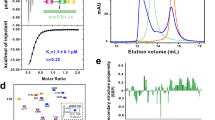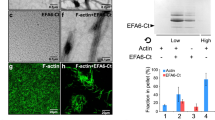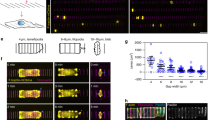Abstract
We have recently isolated two novel actin filament-binding proteins, l-afadin and neurabin-II and shown that they are localized at cell – cell adherens junction (AJ) in epithelial cells. We found here that l-afadin, neurabin-II, ZO-1, and E-cadherin showed similar and different behavior during the formation and destruction of cell – cell AJ in MDCK cells. In MDCK cells, the accumulation of both l-afadin and E-cadherin, but not that of ZO-1, changed in parallel depending on Rac small G protein activity. Dissociation of MDCK cells by culturing the cells at 2 μM Ca2+ caused rapid endocytosis of E-cadherin, but not that of l-afadin or ZO-1. Addition of phorbol 12-myristate 13-acetate to these dissociated cells formed a tight junction-like structure where ZO-1 and l-afadin, but not neurabin-II or E-cadherin, accumulated. We furthermore found that, in non-epithelial EL cells, which expressed E-cadherin and attached to each other, l-afadin, neurabin-II, ZO-1 and E-cadherin were all localized at AJ. In cadherin-deficient L cells, l-afadin was mainly localized at cell – cell contact sites, but ZO-1 was mainly localized at the tip area of cell processes. Neurabin-II did not accumulate at the plasma membrane area. Neither l-afadin nor neurabin-II significantly interacted with α-, β-catenin, E-cadherin, ZO-1 or occludin.
This is a preview of subscription content, access via your institution
Access options
Subscribe to this journal
Receive 50 print issues and online access
$259.00 per year
only $5.18 per issue
Buy this article
- Purchase on Springer Link
- Instant access to full article PDF
Prices may be subject to local taxes which are calculated during checkout








Similar content being viewed by others
References
Allen PB, Ouimet CC and Greengard P. . 1997 Proc. Natl. Acad. Sci. USA 94: 9956–9961.
Aberle H, Schwartz H and Kemler R. . 1996 J. Cell Biochem. 61: 514–523.
Ando-Akatsuka Y, Saitou M, Hirase T, Kishi M, Sakakibara A, Itoh M, Yonemura S, Furuse M and Tsukita SH. . 1996 J. Cell Biol. 133: 43–47.
Balda MS, Gonzalez-Mariscal L, Matter K, Cereijido M and Anderson JM. . 1993 J. Cell Biol. 123: 293–302.
Bradford MM. . 1976 Anal. Biochem. 72: 248–254.
Bretscher A. . 1993 Curr. Opin. Cell Biol. 5: 653–660.
Cimino G, Moir DT, Canaani O, Williams K, Crist WM, Katzav S, Cannizzaro L, Lange B, Nowell PC, Croce CM and Canaani E. . 1991 Cancer Res. 51: 6712–6714.
Furuse M, Hirase T, Itoh M, Nagafuchi A, Yonemura S, Tsukita Sa and Tsukita Sh. . 1993 J. Cell Biol. 123: 1777–1788.
Furuse M, Ito M, Hirase T, Nagafuchi A, Yonemura S, Tsukita Sa and Tsukita Sh. . 1994 J. Cell Biol. 127: 1617–1626.
Furuse M, Fujita K, Hiiragi T, Fujimoto K and Tsukita Sh. . 1998 J. Cell Biol. 141: 1539–1550.
Geiger B and Ginsberg D. . 1991 Cell Motil. Cytoskeleton 20: 1–6.
Itoh M, Yonemura S, Nagafuchi A, Tsukita Sa and Tsukita Sh. . 1991 J. Cell Biol. 115: 1449–1462.
Itoh M, Nagafuchi A, Yonemura S, Kitani-Yasuda T, Tsukita Sa and Tsukita Sh. . 1993 J. Cell Biol. 121: 491–502.
Itoh M, Nagafuchi A, Moroi S and Tsukita Sh. . 1997 J. Cell Biol. 138: 181–192.
Kartenbeck J, Schmelz M, Franke WW and Geiger B. . 1991 J. Cell Biol. 113: 881–892.
Knudsen KA, Soler AP, Johnson KR and Wheelock MJ. . 1995 J. Cell Biol. 130: 67–77.
Laemmli UK. . 1970 Nature 227: 680–685.
Luna EJ and Hitt AL. . 1992 Science 258: 955–964.
Mandai K, Nakanishi H, Satoh A, Obaishi H, Wada M, Nishioka H, Itoh M, Mizoguchi A, Aoki T, Fujimoto T, Matsuda Y, Tsukita Sh and Takai Y. . 1997 J. Cell Biol. 139: 517–528.
Nakanishi H, Obaishi H, Satoh A, Wada M, Mandai K, Satoh K, Nishioka H, Matsuura Y, Mizoguchi A and Takai Y. . 1997 J. Cell Biol. 139: 951–961.
Nagafuchi A, Shirayoshi Y, Okazaki K, Yasuda Y and Takeichi M. . 1987 Nature 329: 341–343.
Nagafuchi A, Takeichi M and Tsukita Sh. . 1991 Cell 65: 849–857.
Nelson WJ, Shore EM, Wang AZ and Hammerton RW. . 1990 J. Cell Biol. 110: 349–357.
Ozawa M, Baribault H and Kemler R. . 1989 EMBO J. 8: 1711–1717.
Papkoff J. . 1997 J. Biol. Chem. 272: 4536–4543.
Prasad R, Gu Y, Alder H, Nakamura T, Canaani O, Saito H, Huebner K, Gale RP, Nowell PC, Kuriyama K, Miyazaki Y, Croce CM and Canaani E. . 1993 Cancer Res. 53: 5624–5628.
Rimm DL, Koslov ER, Kebriaei P, Cianci CD and Morrow JS. . 1995 Proc. Natl. Acad. Sci. USA 92: 8813–8817.
Satoh A, Nakanishi H, Obaishi H, Wada M, Takahashi K, Satoh K, Hirao K, Nishioka H, Hata Y, Mizoguchi A and Takai Y. . 1998 J. Biol. Chem. 273: 3470–3475.
Takaishi K, Sasaki T, Kotani H, Nishioka H and Takai Y. . 1997 J. Cell Biol. 139: 1047–1059.
Takeichi M. . 1988 Development 102: 639–655.
Takeichi M. . 1991 Science 251: 1451–1455.
Tsukita Sh, Tsukita Sa, Nagafuchi A and Yonemura S. . 1992 Curr. Opin. Cell Biol. 4: 834–839.
Tsukita Sa, Yonemura S and Tsukita Sh. . 1997 Trends Biochem. Sci. 22: 53–58.
Turner CE and Burridge K. . 1991 Curr. Opin. Cell Biol. 3: 849–853.
Yamamoto T, Harada N, Kano K, Taya S, Canaani E, Matsuura Y, Mizoguchi A, Ide C and Kaibuchi K. . 1997 J. Cell Biol. 139: 785–795.
Weiss EE, Kroemker M, Rüdiger AH, Jockusch BM and Rüdiger M. . 1998 J. Cell Biol. 141: 755–764.
Acknowledgements
We thank Drs Sh Tsukita, A Nagafuchi and M Itoh (Kyoto University, Kyoto, Japan) for providing us with the anti-ZO-1 Ab, EL cells, L cells and the GST-fusion vectors, containing α- and β-catenins, the cytoplasmic region of E-cadherin, the N-terminal and C-terminal fragments of ZO-1 and the cytoplasmic region of occludin. We also thank Dr W Birchmeier (Max-Delbruck-Center for Molecular Medicine, Berlin, Germany) for providing us with MDCK cells. The work performed at Osaka University Medical School was supported by grants-in-aid for Scientific Research and for Cancer Research from the Ministry of Education, Science, Sports, and Culture, Japan (1998), by grants-in-aid for Abnormalities in Hormone Receptor Mechanisms and for Aging and Health from the Ministry of Health and Welfare, Japan (1998), and by grants from the Human Frontier Science Program (1998).
Author information
Authors and Affiliations
Rights and permissions
About this article
Cite this article
Sakisaka, T., Nakanishi, H., Takahashi, K. et al. Different behavior of l-Afadin and Neurabin-II during the formation and destruction of cell – cell adherens junction. Oncogene 18, 1609–1617 (1999). https://doi.org/10.1038/sj.onc.1202451
Received:
Revised:
Accepted:
Published:
Issue Date:
DOI: https://doi.org/10.1038/sj.onc.1202451
Keywords
This article is cited by
-
Proximity proteomics identifies PAK4 as a component of Afadin–Nectin junctions
Nature Communications (2021)
-
Involvement of nectin in the localization of IQGAP1 at the cell–cell adhesion sites through the actin cytoskeleton in Madin–Darby canine kidney cells
Oncogene (2003)
-
Involvement of nectin in the localization of junctional adhesion molecule at tight junctions
Oncogene (2002)
-
Localization of mLin-7 at nectin-based cell–cell junctions
Oncogene (2002)
-
Restoration of E-cadherin-based cell–cell adhesion by overexpression of nectin in HSC-39 cells, a human signet ring cell gastric cancer cell line
Oncogene (2002)



